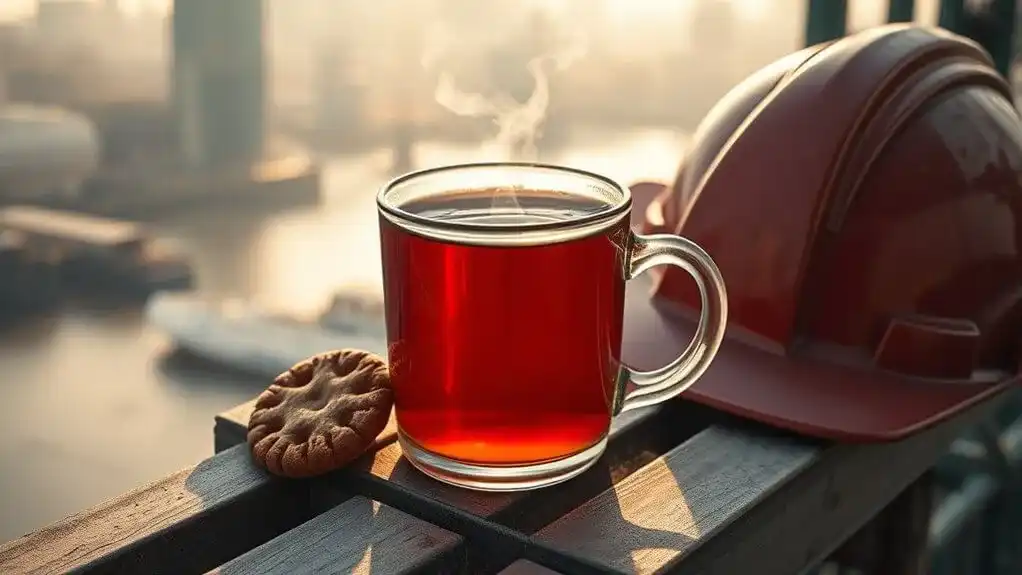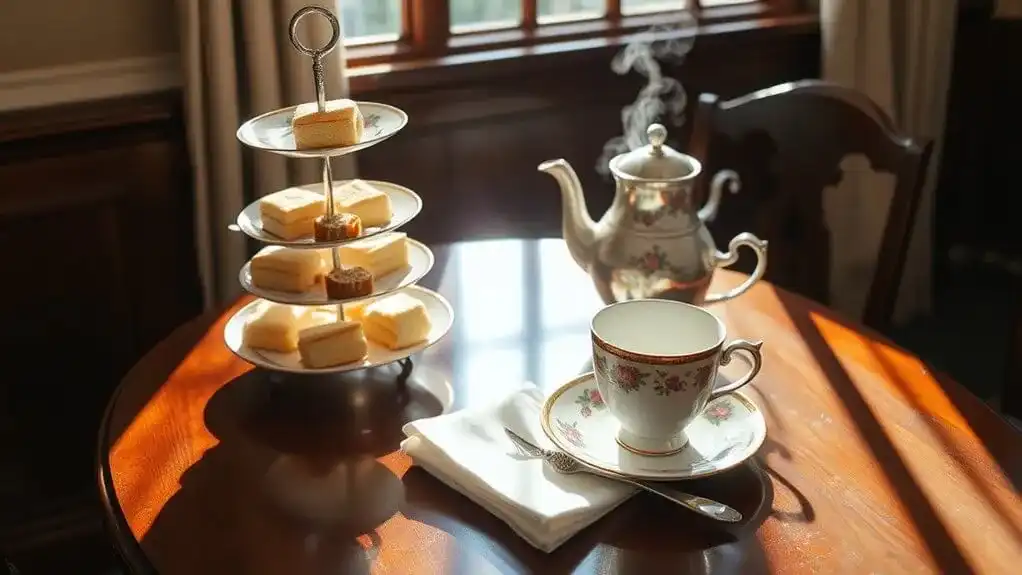Builder's tea emerged during Britain's Industrial Revolution as a robust, energizing drink for factory workers. Its strong brew and generous portions of milk and sugar provided essential sustenance during long workdays, while boiling water helped combat waterborne diseases. What began as a practical solution became deeply woven into British culture, evolving from construction sites to kitchen tables. This hearty brew's rich history reveals much about Britain's working-class heritage and enduring traditions.
Key Points
- Builder's tea emerged during the Industrial Revolution as an energizing drink for factory workers, providing both sustenance and protection from waterborne diseases.
- The strong, robust brewing method reflects Britain's industrial heritage, with extended steeping times creating a distinctively powerful flavor profile.
- Shared tea breaks fostered workplace camaraderie and improved productivity, establishing lasting social rituals that continue in modern British work culture.
- British soldiers' reliance on strong tea during World War II reinforced its cultural significance and cemented its place in national identity.
- Despite modern alternatives, builder's tea remains a symbol of British working-class resilience and solidarity, maintaining its cultural importance across generations.
The Birth of Britain's Most Robust Brew

Three major historical forces shaped the birth of builder's tea: the Industrial Revolution, World War II, and Britain's post-war economic recovery. During the Industrial Revolution, factory workers needed a quick, energizing drink to power through long shifts, establishing tea breaks as a crucial workplace ritual. The cultural connections deepened when British soldiers carried strong tea through World War II's battlefields, creating lasting historical anecdotes about the nation's reliance on this robust brew. By the 1970s, as Britain's economy rebounded, a thriving blue-collar culture demanded affordable, fast-brewing tea that could withstand the rigors of construction sites and factory floors. Yorkshire Tea and other brands embraced this heritage, cementing builder's tea as an enduring symbol of British working-class resilience and camaraderie. These workers preferred their tea brewed longer and stronger, making it the perfect accompaniment for their demanding physical labor. The tradition of adding milk and sugar became standard practice to balance the intense bitterness while maintaining the drink's revitalizing properties. Construction workers particularly favored teas from African regions for their bold, robust flavors.
What Makes Builder's Tea Different

While many tea varieties grace British cupboards, builder's tea stands apart through its distinctive preparation and robust character. The brewing techniques involve steeping strong black tea leaves for 5-7 minutes in boiling water, considerably longer than typical tea preparation. This creates a dark, intense brew that's balanced with generous amounts of whole milk and sugar.
The cultural significance of builder's tea is deeply rooted in Britain's working-class history, particularly within the construction industry. It's designed to provide both sustenance and energy, with each cup containing around 47mg of caffeine. The full bodied taste makes it especially satisfying for those seeking a stronger cup. What truly sets it apart is its practical, no-nonsense approach – it's a straightforward brew that prioritizes strength and functionality over delicate flavors, making it the perfect companion for those seeking a hearty, energizing drink during their workday.
The Industrial Revolution's Perfect Companion

During Britain's Industrial Revolution, builder's tea emerged as an essential companion to the nation's workforce, perfectly aligned with the demands of a rapidly industrializing society. Factory workers relied on this robust brew for its energizing properties and practical health benefits, as boiling water for tea helped combat widespread waterborne diseases. The tradition of adding milk to tea became standard practice among workers seeking comfort during their grueling shifts. Under the influence of companies like Lipton brand, tea became more affordable and consistent in quality for the working class.
Tea rituals became deeply embedded in workplace culture, with scheduled breaks fostering labor camaraderie and improved productivity. The government recognized tea's importance, particularly during World War II, ensuring strict ration management to maintain worker morale. The drink's affordability, quick brewing time, and high caffeine content made it ideal for laborers facing long shifts and physical demands. Traditional brands like Tetley's and PG Tips became synonymous with this working-class beverage that helped fuel Britain's industrial expansion.
From Construction Sites to Kitchen Tables

Builder's tea's journey from construction sites to British homes represents a remarkable cultural shift in tea consumption. What began as a practical drink for laborers has evolved into a beloved national beverage that transcends social boundaries.
The traditional builder's tea rituals, once exclusive to construction sites, now find their place in households across Britain. The robust brew, known for its strong flavor and straightforward preparation, continues to embody the values of simplicity and reliability. While construction camaraderie initially centered around sharing tea breaks with colleagues, this sense of community has expanded beyond work sites. Today's builder's tea is typically strong, milky, and sweet. Though modern alternatives like coffee and energy drinks have emerged, established brands such as Yorkshire Tea keep the tradition alive, ensuring that builder's tea remains an integral part of British culture.
The Art of Brewing the Perfect Builder's Tea

Creating the perfect cup of builder's tea requires mastering four essential elements: precise timing, proper ingredients, careful technique, and cultural authenticity.
The brewing techniques start with selecting strong British tea bags like PG Tips or Typhoo, then steeping them for 5-6 minutes in freshly boiled water. Raw cane sugar should be added during steeping for optimal sweetness. Regular stirring during this process helps extract the full flavor profile, resulting in a deep brown brew with a rich, sweet taste. For the smoothest results, using semi-skimmed milk creates the ideal consistency. Once the tea bag's removed, whole milk is added gradually while stirring until achieving the signature caramel color. The convenience of modern IoT brewers has made it easier for busy tea enthusiasts to achieve consistent results.
While modern devices like the Qi Aerista can automate the process, traditional preparation in a sturdy mug remains the preferred method. The final product should be strong and slightly thick, reflecting its origins on British construction sites where workers needed a robust, energizing drink.
A Symbol of British Work Culture

A steaming cup of builder's tea stands as one of Britain's most enduring symbols of working-class culture, tracing its origins to the Industrial Revolution when laborers needed quick, energizing refreshment. This robust brew evolved from a practical necessity into a cornerstone of tea traditions that fostered work camaraderie across construction sites and factories throughout the nation. The tradition reflects how tea drinking became a social lubricant that helped unite workers across different backgrounds.
During World War II, the government recognized builder's tea's importance to worker morale, carefully managing tea rations to maintain this essential cultural practice. The ritual of sharing strong, milky tea transcended class barriers, uniting workers regardless of their rank or role. While recent trends show that construction workers are increasingly choosing coffee and soft drinks, this dark, distinctive blend continues to represent the values of resilience and solidarity that have long characterized British work culture, serving as a reflection of the nation's industrial heritage.
The Legacy and Modern Significance

The enduring significance of builder's tea extends far beyond its working-class origins, shaping Britain's cultural identity well into the 21st century. While modern energy drinks and specialty coffees have emerged as alternatives, builder's tea remains a powerful symbol of tea nostalgia and workplace solidarity.
The cultural evolution of this robust brew hasn't diminished its importance in British society. Traditional brands like Yorkshire Tea, PG Tips, and Tetley's continue to honor the legacy of this strong, milky beverage that once fueled the nation's industrial workforce. Even as workplace cultures change, the ritual of sharing builder's tea maintains its role in fostering camaraderie and providing moments of respite during the workday, proving that some traditions are too meaningful to fade away.
Conclusion
While some may dismiss builder's tea as just another working-class beverage, it's become an enduring symbol of British resilience and practicality. From its origins in construction sites to its place in modern homes, this robust brew hasn't just sustained workers through tough days – it's woven itself into the fabric of British culture. Builder's tea continues to unite people across social boundaries, one strong cuppa at a time.


